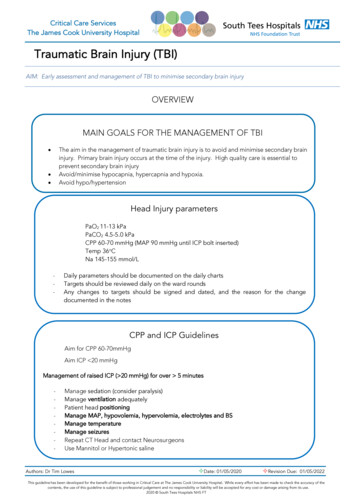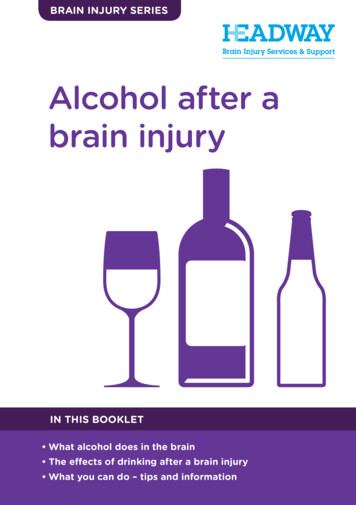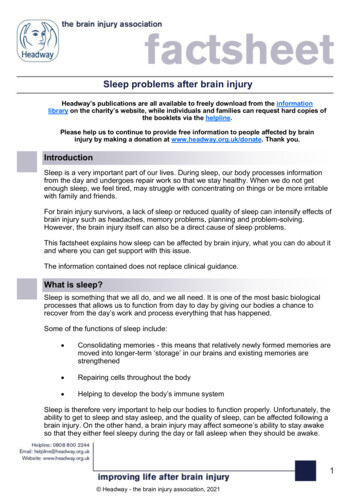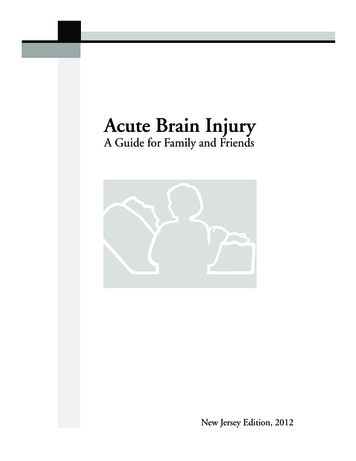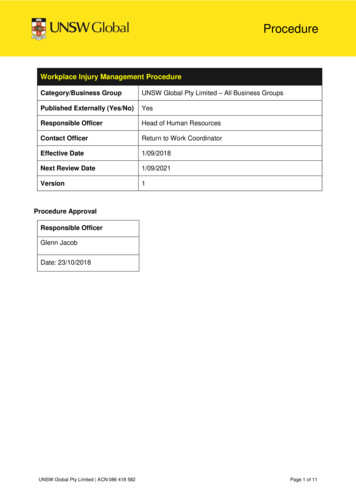
Transcription
Orr et al. Military Medical Research(2020) ARCHOpen AccessModels to predict injury, physical fitnessfailure and attrition in recruit training: aretrospective cohort studyRobin M. Orr1* , Bruce S. Cohen2, Stephen C. Allison2, Lakmini Bulathsinhala2, Edward J. Zambraski2 andMark Jaffrey3AbstractBackground: Attrition rate in new army recruits is higher than in incumbent troops. In the current study, weidentified the risk factors for attrition due to injuries and physical fitness failure in recruit training. A variety ofpredictive models were attempted.Methods: This retrospective cohort included 19,769 Army soldiers of the Australian Defence Force receiving recruittraining during a period from 2006 to 2011. Among them, 7692 reserve soldiers received a 28-day training course,and the remaining 12,077 full-time soldiers received an 80-day training course. Retrieved data includedanthropometric measures, course-specific variables, injury, and physical fitness failure. Multivariate regression wasused to develop a variety of models to predict the rate of attrition due to injuries and physical fitness failure. Thearea under the receiver operating characteristic curve was used to compare the performance of the models.Results: In the overall analysis that included both the 28-day and 80-day courses, the incidence of injury ofany type was 27.8%. The 80-day course had a higher rate of injury if calculated per course (34.3% vs. 17.6%in the 28-day course), but lower number of injuries per person-year (1.56 vs. 2.29). Fitness test failure rate wassignificantly higher in the 28-day course (30.0% vs. 12.1%). The overall attrition rate was 5.2 and 5.0% in the28-day and 80-day courses, respectively. Stress fracture was common in the 80-day course (n 44) and rare inthe 28-day course (n 1). The areas under the receiver operating characteristic curves for the course-specificpredictive models were relatively low (ranging from 0.51 to 0.69), consistent with “failed” to “poor” predictiveaccuracy. The course-combined models performed somewhat better than the course-specific models, withtwo models having AUC of 0.70 and 0.78, which are considered “fair” predictive accuracy.Conclusion: Attrition rate was similar between 28-day and 80-day courses. In comparison to the 80-day fullcourse, the 28-day course had a lower rate of injury but a higher number of injuries per person-year and offitness test failure. These findings suggest fitness level at the commencement of training is a criticallyimportant factor to consider when designing the course curriculum, particularly short courses.Keywords: Military training, Predictive modelling, Risk management, Soldier* Correspondence: rorr@bond.edu.au1Tactical Research Unit, Bond University, 2 Promethean Way, Gold Coast,Robina, QLD 4226, AustraliaFull list of author information is available at the end of the article The Author(s). 2020 Open Access This article is licensed under a Creative Commons Attribution 4.0 International License,which permits use, sharing, adaptation, distribution and reproduction in any medium or format, as long as you giveappropriate credit to the original author(s) and the source, provide a link to the Creative Commons licence, and indicate ifchanges were made. The images or other third party material in this article are included in the article's Creative Commonslicence, unless indicated otherwise in a credit line to the material. If material is not included in the article's Creative Commonslicence and your intended use is not permitted by statutory regulation or exceeds the permitted use, you will need to obtainpermission directly from the copyright holder. To view a copy of this licence, visit http://creativecommons.org/licenses/by/4.0/.The Creative Commons Public Domain Dedication waiver ) applies to thedata made available in this article, unless otherwise stated in a credit line to the data.
Orr et al. Military Medical Research(2020) 7:26BackgroundBasic combat training prepares recruits for the demandsof military life through physical training, combat training, and general military skill training [1, 2]. Recruits aretypically drawn from the general population and commence training with varying levels of physical activity experience and fitness. The sudden increase in physicaldemands, the complexity of new physical tasks, and a reduced opportunity for recovery can lead to overtraining,and it is therefore not surprising that new recruits are atgreater risk for musculoskeletal injury when comparedto operational or incumbent soldiers [3–5].Recruit injuries present a significant fiscal andpersonnel burden to military services, as injured recruitsare up to 10 times less likely to complete recruit training[6]. In 1999, 59.0% of recruits in the Australian Armybasic recruit training course were discharged as “medically unfit” [6]. The most common activities noted ascausing injuries in Australian Regular Army recruits specifically were running (21.3%), marching (14.4%) andwalking (7.0%). The two most frequently reported mechanisms of injury were overuse (33.4%) and overexertion(12.4%) [6].As injuries delay graduation and increase attrition,both of which reduce the level of force readiness andavailability for deployment [7–9], early identification ofthe trainees most at risk of training failure and musculoskeletal injuries is important. Screening levels haveshown promising results, as apart from musculoskeletalinjuries, poor physical fitness performance has beenidentified as a leading cause of attrition and delayedmilitary recruit graduation in new recruits. A study byPope et al. [6] predicting Australian Regular Army recruits’ risk of injury and attrition found that a score oflevel 3.5 on the 20-m multistage fitness test (MSFT), indicating low cardiovascular fitness, was associated with14.2 times the risk of injury compared with a score oflevel 13.5. However, the remaining two components ofthe physical fitness assessment (push-ups and sit-ups)were poor predictors of injury [10]. The findings of thisstudy are consistent with those from the general literature, which has likewise identified a lower level of fitnessas a predictor of training failure in both general trainees(e.g., initial entry recruits and officers) [7, 11] and specialists (e.g., special forces trainees) [12]. Therefore, theaim of this study was to determine the best-fit analyticmodels for predicting injury, attrition, and failure to passthe final physical fitness test based on available predictorvariables (including sex, age, and physical fitness assessment results) and common statistical methods.MethodsData were retrospectively collected from two AustralianArmy recruit training courses during a period from 2006Page 2 of 10to 2011: a 28-day reservist training course for Army reserve soldiers and an 80-day basic recruit training coursefor full-time soldiers. An identical set of entry standardswere met in the two cohorts prior to training commencement. All training courses were conducted at asingle site. Typically, a new cohort started the trainingevery week throughout the year; on occasions, two cohorts started at the same time with a longer gap of twoor 3 weeks between cohorts (e.g., over the Decemberholiday period). The study was approval by the Australian Defence Human Research Ethics Committee(AF6185869), with all interagency cooperation documents, including the Cooperative Research and Development Agreement for Material Transfer and the TransferAgreement for Existing Specimens or Data and the DataTransfer Agreements, signed.Injury dataInjury data were retrieved from the Defence Injury Prevention Program (DIPP) that included an injury surveillance tool for documentation of injuries in the 28- and80-day recruit training courses. DIPP injury data included the type, location, activity during injury, action,severity and mechanism (cause). Data were collected atpoint-of-care facilities by medical staff, physiotherapistsor physical training instructors (PTI) who closely monitored the program delivery and medical care for thosesustaining injuries. All incidents that led to health careattention by a medical assistant, doctor or other healthprofessional were documented in this system. This system has previously been shown to document up to 10times as many of the injuries actually occurring as compared to the Australian Defence Force (ADF)’s DefenceWork Health and Safety incident reporting system [13].Physical fitness assessmentsTwo fitness assessments were conductedthe Pre-enlistment Fitness Assessment (PFA) and theRecruit Fitness Assessment (RFA). The PFA consisted ofpush-ups, sit-ups and the 20-m MSFT and was conducted within 24 h of arrival at the training camp. If arecruit failed to meet the minimum standard (see Additional file 1: Table S1), a retest was scheduled for thenext day. If a recruit failed the retest, he/she was removed from the training course and sent for remedialtraining in a separate platoon. The RFA was conductedin the last week of recruit training, with the same assessment items with the exception of the 20-m MSFT whichwas replaced with a 2.4 km run (see Additional file 1:Table S1). All assessments were conducted by Army PTIwho undergo extensive and dedicated training in the application of these assessments, in accordance with formalized ADF protocols [14].
Orr et al. Military Medical Research(2020) 7:26The push-upThe recruits began the test in the standard “up” position,with the body held in a straight line from head to heelsand only hands and feet touching the floor. Oncommand, the recruits bent their elbows and loweredthemselves until their upper arms were parallel to theground. The recruits then straightened their arms untilthey were back in the “up” position. Recruits wereinstructed to perform as many repetitions as possible in2 min. Recruits could rest in the “up” position, with thehips raised or lowered; but had to return to the correct“up” position before commencing the next repetition.Prior to expiration of the 2 min, the test could beterminated when the recruits could no longer completethe push-up or were told to stop by the instructor dueto safety concerns.The sit-upThe sit-up assessment was conducted to an audiocadence of 1 repetition every 3 s. Recruits lay supine ona mat with their knees bent to 90 degrees and their feeton the floor. A partner could hold the feet secure to thefloor if the recruit wished. Arms were straight with thepalms resting on the front of the thighs and fingersextended. On the pre-recorded command “raise”, therecruits sat up until their wrists were over the top oftheir kneecaps and then lowered down at their own pacein preparation for the next repetition. The recruits’ feetand hips were not allowed to leave the floor, nor couldthey use their upper body to generate momentum. Thetest could be terminated when the recruit could nolonger keep up with the audio recording or was told tostop by the instructor due to safety concerns.The 20-m MSFTEach level of the MSFT consisted of several 20-mshuttles. As the test progressed, the time allowed foreach shuttle was reduced, so recruits were required toincrease their running speed to complete the shuttle inthe time allowed for each successive level. The testbegan at a speed just above a quick walking pace andincreased to a full running speed at Level 7.5 (theminimum passing standard). If the recruit failed to placeone foot on or over the 20-m line by the requiredauditory tone on two successive occasions or on threeoccasions cumulatively, the test was terminated, and thelast successfully completed level was recorded.The 2.4-km runThe recruit was required to complete a 2.4-km course asfast as possible. The course was conducted on a flat pathwith minimal undulating terrain. The time to completethe course was the measured outcome.Page 3 of 10Data preparation and analysisThe Australian Army data set included the DIPP injurydata, performance data (initial, mid- and post-coursefitness tests), and course start/completion dates. Thedata set also included basic anthropometric variables(age, height, weight) and course-specific variables(course number and military unit of assignment).All data, character and numeric variable lengths,formats and properties were standardized. The resultingdata were scrutinized to eliminate impossible or unlikelyvalues that appeared to be due to data entry errors.Values outside the ranges of the accession standards (17to 60 years of age, height 152 cm, weight 42 to 150 kg,or body mass index (BMI) 18.5 to 32.9) were changed tomissing values. Furthermore, data that could notaccurately be read from paper-based entries or werecoded as pass/fail were also changed to missing values.Descriptive statistics were used to characterize thedemographic and performance attributes of the recruitsin the two recruit training courses and to quantifyattrition and failure to pass the final physical fitness testbattery. To determine the injury proportion (% ofinjuries), the number of personnel suffering one or moreinjuries was divided by the total number of recruits andmultiplied by 100. The injury incidence rate (injuries perperson-year) was calculated by dividing the number ofrecorded injuries by the length of the course and thepopulation size and multiplying the result by 365 days.Predictive models were developed for all targetedoutcomes for each course separately and in combination. There were eight predictor variables availablein the data set for the course-specific models at ornear the beginning of training: age, sex, height,weight, BMI, initial 20-m MSFT, sit-ups, and pushups. When models were established using bothcourses, course type (duration) became the 9th potential predictor variable. Given that the PFA teststended to be assessed with recruits stopping uponattaining the minimum passing standards, thesetests were also assessed for their predictive valueafter transformation to dichotomous pass/fail variables. Predicted outcomes in the models were anyinjury, overuse injury, stress fracture, neuromuscularinjury, traumatic injury, attrition, and failure to passthe RFA. The injury subcategories for the predictionmodel were based on known injury concerns inmilitary populations and areas of interest to research [1, 15]. A recruit was considered to havefailed the RFA if the minimal passing standardswere not met for one or more of the three individual tests.Univariate analyses (unpaired t-tests for continuousvariables and Chi-square test for sex) was used to selectpotential predictor variables for inclusion into the
Orr et al. Military Medical Research(2020) 7:26multivariate regression at a threshold of P 0.20 [16].Binary logistic regression was then used to filter the setsof potential predictor variables and to derive multivariatemodels to minimize redundant or substantially correlated predictors or predictors that did not contributemeaningfully to the multivariate prediction. The final logistic regression was performed using a forward conditional stepwise procedure with probability level at 0.05for entry and 0.10 for removal. Logits for each recruitwere computed from the final logistic regression equations and subsequently transformed into estimated probabilities of respective outcomes for every individual inthe data set using the inherent transformation algorithmin the analytic software. The estimated probabilities forthe outcomes, combined with observed occurrences ornon-occurrence’s for injury and performance outcomes,were then used to construct receiver operating characteristic (ROC) curves. The areas under the curves (AUC)were computed to provide a general indication of performance risk for the models. A minimum AUC of 0.70was expected for a model to have minimally acceptablepredictive accuracy [17, 18].Discriminant function analyses (DFA) were performedto construct potential alternative models for injuries andpoor performance. Estimated probabilities of injury andperformance outcomes were also computed based onthe derived discriminant functions. ROC curves wereconstructed for these DFA-derived probability distributions as described above.The model-based probability of each outcome was dichotomized into higher vs. lower probability using tablesof coordinate points for the ROC curves and the Youdenindex [19]. The predictive performance of each model,using the maximum value in the distribution of YoudenIndices as the cut score, was then characterized by calculating sensitivity, specificity, positive and negative predictive values, and positive and negative likelihoodratios. These predictive accuracy statistics were computed from 2 2 contingency tables containing frequency counts expressing numbers of recruits with truepositive test results, false positive test results, true negative test results, and false negative test results. SPSS (version 23, IBM Corp, Armonk, NY, US) [20] was used forall statistical analyses.ResultsThe initial nonidentifiable data set contained resultsfrom 22,085 recruits completing their recruit trainingcourses during the years 2006 to 2011. Data were deleted for all trainees in courses #202512 (n 478) and#202513 (n 172) as their data sets were incomplete.Data were also deleted for all entries assigned to theTraining Support Company (n 1666), given that theseindividuals were mostly those who were recycledPage 4 of 10through training because of injuries or other difficultiesduring initial training attempts or were staff membersposted to assist in the training process. The final analysisincluded a total of 19,769 recruits (28-day course,n 7692, 87.0% men; 80-day course, n 12,077, 91.8%men). For both courses combined, the average recruitage was 22.2 6.10 years.The incidence of any type of injury during trainingwas 27.8% in both courses combined. The proportion injured at least once was significantly lower in the 28-daycourse (17.6% vs. 34.3% in the 80-day course; P 0.001).Accounting for exposure time, however, the any-type incidence rate was higher in the 28-day course (2.29 vs.1.56 injuries per person-year in the 80-day course).Overall, women had a higher any-type injury incidence(43.3%) than men (26.0%) in both courses combined(P 0.001); this held true even when exposure time wasaccounted for: 1.97 injuries per person-year for womenand 1.19 injuries per person-year for men in bothcourses combined. When all-type injury incidence wasstratified by both course type and sex, 31.0% of womenwere injured in the 28-day course (4.05 injuries perperson-year) compared to only 15.5% of men (2.03 injuries per person-year). During the 80-day course, 55.7% ofwomen experienced at least one type of injury (2.54 injuries per person-year), whereas only 32.4% of men wereinjured (1.48 injuries per person-year). A total of 45stress fractures were recorded (13 in women; 32 inmen), with an overall incidence of 0.2%; all but one occurred in the 80-day course, and all but one were lowerextremity stress fractures. Attrition rate was not significantly different in the two courses: 5.2% in the 28-daycourse and 5.0% in the 80-day course (P 0.66). The ratefor failure to pass the final battery of fitness assessments(i.e., the RFA) was significantly higher in the 28-daycourse (30.0% vs. 12.1% in the 80-day course; P 0.001).Detailed descriptive statistics are presented in Table 1.Models derived with logistic regression and discriminant function analyses retained identical sets of predictorvariables, and the resulting ROC curves were similar –with AUCs differing by no more than 5.0% betweenmodel derivation methods. Where there were differences, the logistic regression models generally performedslightly better than the other models. Therefore, the results of the logistic regression analyses are presentedbelow.Course-specific predictive modelsThe models created for each course separately retained1 to 6 predictors, with AUCs for the associated ROCcurves ranging from 0.51 (predicting attrition in the 80day course) to 0.69 (predicting stress fracture in the 80day course). All models were statistically significant withomnibus tests of coefficients 0.028. All models showed
Orr et al. Military Medical Research(2020) 7:26Page 5 of 10Table 1 Descriptive statistics for the demographic, performance, and injury variablesItemaAge [year, mean SD (n)]28-day Reservist Course80-day Standard CourseFemalesMalesFemalesMales25.3 7.4(1001)24.1 7.4(6686)20.7 4.8(990)21.0 4.7(11085)a166.2 6.7(789)179.0 7.2(5444)165.4 6.2(845)178.8 7.0(9129)a63.1 8.1(810)78.5 10.8(5549)63.3 8.5(864)78.1 11.3(9371)Height [cm, mean SD (n)]Weight [kg, mean SD (n)]a22.9 2.4(787)24.5 2.9(5407)23.1 2.6(840)24.4 3.1(9099)aBody mass index [kg/m2, mean SD (n)]8.3 2.3(535)15.0 1.0(3906)8.6 2.7(596)15.0 0.9(6413)a52 (9.7%, 535)63 (0.9%, 3906)50 (8.4%, 596)82 (1.3%, 6413)a44.8 3.2(542)45.0 1.6(3907)45.4 6.0(607)45.2 2.7(6412)Initial Push-ups [repetitions, mean SD (n)]Initial Push-ups Failure [No., (%, n)]Initial Sit-ups [repetitions, mean SD (n)]Initial Sit-ups failure [No., (%, n)]a14 (2.6%, 542)21 (0.5%, 3907)15 (2.5%, 607)33 (0.5%, 6412)a7.3 0.7(542)7.5 0.3(3911)7.3 0.9(608)7.5 0.2(6414)a100 (18.5%, 542)80 (2.0%, 3911)105 (17.3%, 608)83 (1.3%, 6414)Final Push-ups [repetitions, mean SD (n)]25.2 9.9(431)43.2 12.2(3302)27.0 8.1(513)46.5 11.8(5942)Initial Shuttle run [level, mean SD (n)]Initial Shuttle run failure [No., (%, n)]Final Sit-ups [repetitions, mean SD (n)]91.6 17.2(439)94.9 12.4(3322)96.6 9.5(515)97.6 7.7(5953)Final 2.4-km run [min, mean SD (n)]11.7 0.9(395)10.3 0.9(3111)11.5 0.7(495)9.9 0.8(5794)b31.0% (311/1002)15.5% (1040/6690)55.7% (551/990)32.4% (3587/11,087)b18.1% (181/1002)8.2% (550/6690)45.9% (454/990)21.1% (2337/11,087)Any injury (%)Overuse injury (%)b0% (0/1002)0.0% (1/6690)1.3% (13/990)0.3% (31/11,087)b28.9% (290/1002)13.2% (880/6690)49.9% (494/990)28.4% (3152/11,087)b10.9% (109/1002)6.1% (409/6690)25.6% (256/990)14.4% (1598/11,087)b7.9% (27/341)4.4% (51/1148)4.5% (27/599)5.0% (198/3945)b28.0% (112/400)30.2% (953/3152)8.9% (44/497)12.4% (716/5797)Stress fracture (%)Neuromuscular injury (%)Traumatic injury (%)Attrition (%)Final RFA battery failure (%)The results are presented as the mean SD for continuous-scale variables and as a number (% of total) for dichotomous outcomes (injuries, attrition, and failureon the final test battery). The percentage of total values for attrition and failure on the final test battery may be underestimated due to missing values. aPotentialpredictor variables. bOutcome variables for the predictive models. RFA. Recruit Fitness Assessmentacceptable goodness of fit, with the Hosmer-Lemeshowtests all being nonsignificant. However, the NagelkerkeR2 values were quite low, ranging from 0.01 to 0.10. Theretained predictors, pseudo-R2 values, and AUCs arepresented in Table 2 with the corresponding predictiveequations in Table 3. Risk accuracy profiles for eachcourse-specific model are presented in Additional file 2:Table S2 using cutoff values determined with the maximum Youden index.Predictive models including course type/duration as apredictorThe models created with the combined data retained 2to 7 predictors, with AUCs for the associated ROCcurves ranging from 0.59 (predicting attrition) to 0.78(predicting stress fracture). Course type was retained asa predictor in all models except for that for attrition. Allmodels were statistically significant with omnibus testsof coefficients 0.001. All models showed acceptablegoodness of fit, with the Hosmer-Lemeshow tests all being nonsignificant. Here, the Nagelkerke R2 values wererelatively small. However, predictive performance wasgenerally better with course-specific model
Army recruit training courses during a period from 2006 to 2011: a 28-day reservist training course for Army re-serve soldiers and an 80-day basic recruit training course for full-time soldiers. An identical set of entry standards were met in the two cohorts prior to training com-mencement. All training courses were conducted at a single site.

